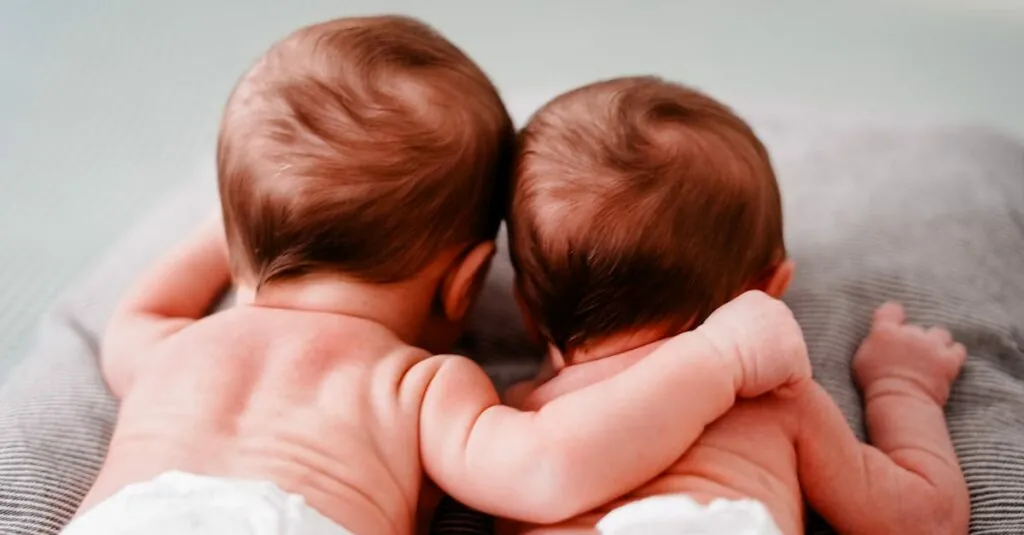Table of Contents
ToggleNewborns are tiny bundles of joy, but they come with their own set of mysteries—like the age-old question: how long do they really wear newborn diapers? It’s a topic that can leave new parents scratching their heads and frantically Googling while juggling a wailing baby. Spoiler alert: it’s not as straightforward as one might hope.
Overview of Newborn Diapers
Newborn diapers cater specifically to infants weighing up to 10 pounds. The size and design accommodate the unique needs of newborns as they often experience frequent urination and bowel movements. Parents typically find the fit is snug yet comfortable, reducing the chances of leaks.
A standard newborn diaper holds up to 8 ounces of fluid, making it essential for parents to monitor diaper changes regularly. Most healthcare providers recommend changing a diaper every 2 to 3 hours or whenever it’s soiled. This approach helps maintain skin health and minimize potential diaper rash.
Some brands offer a range of absorbency levels. Higher absorbency can be beneficial during nighttime use, preventing leaks while the baby sleeps. Conversely, daytime use often allows for thinner, more breathable options.
In terms of duration, newborns usually transition out of this diaper size around 6 to 8 weeks, depending on their growth rate. Monitoring the baby’s weight growth can give clues about when to switch to size one diapers, typically indicated when the infant approaches the 10-pound threshold.
Parents notice diaper sizes can vary among brands, so checking the weight guidelines on the packaging is critical to ensure a proper fit. When selecting newborn diapers, factors such as softness, absorbency, and hypoallergenic materials contribute to the baby’s comfort and health.
Choosing the right newborn diaper makes a significant difference in easing the challenges of diapering, allowing parents to focus more on caring for their newborns.
Factors Affecting Duration
Newborns typically wear newborn diapers for a limited period. Several key factors influence how long this lasts.
Size and Weight Considerations
Newborn diapers accommodate infants weighing up to 10 pounds. Diaper sizes vary among brands, emphasizing the importance of checking packaging for accurate guidelines. Parents must monitor their baby’s weight closely, as transitioning occurs when the infant approaches this threshold. If a newborn consistently stays below 10 pounds, they may use these diapers longer than average. Regularly assessing diaper fit helps ensure comfort and prevents leaks.
Growth Patterns
Newborn growth rates directly affect diaper duration. Infants usually experience rapid weight gain during the first weeks of life. Some newborns might exceed the 10-pound mark by 6 weeks, while others may take a bit longer. Individual differences in metabolism and health can result in varying timelines for transitioning to size one diapers. Parents should remain attentive to changes in their baby’s body, ensuring a proper fit remains a top priority. Observing growth patterns aids in determining the appropriate diaper size when the time comes.
Typical Duration for Newborns
Newborns typically wear newborn diapers for about 6 to 8 weeks. Growth rates influence this timeframe, and babies’ weight plays a crucial role in the transition to size one diapers.
Average Age Range
Most babies transition out of newborn diapers by 6 to 8 weeks. Weighing around 10 pounds signals the shift to the next size. Some infants may exceed this weight by 6 weeks, while others might take longer. Monitoring weight is essential, as each baby’s growth patterns affect diaper size readiness. Brands often provide weight ranges on packaging, helping parents determine when to switch sizes.
Signs of Transitioning
Parents can look for specific signs indicating it’s time for a diaper size change. Frequent leaks or diapers fitting snugly suggest the need for a larger size. If the diaper appears too tight or leaves red marks, it’s crucial to consider transitioning. Additionally, if the baby consistently wets through the diaper before the usual changing schedule, a change in size could help. Observing these signs helps ensure comfort and minimizes the risk of diaper rash.
Choosing the Right Diaper
Selecting the appropriate diaper for a newborn involves considering several key factors.
Types of Newborn Diapers
Various types of newborn diapers exist, each catering to different needs. Disposable diapers offer convenience with high absorbency, perfect for busy parents. Cloth diapers, eco-friendly and reusable, provide a sustainable option but require more maintenance. Hybrid models combine disposable and cloth features, offering flexibility for parents. Additionally, some brands market specialized diapers for nighttime use, ensuring extended protection during sleep. These options allow parents to choose based on lifestyle preferences and baby’s needs.
Tips for Selection
Several tips can guide parents in selecting the right diapers. First, always check weight guidelines on packaging as they help determine the right size. Second, prioritize softness and comfort to promote healthy skin, reducing the risk of irritation. Next, assess absorbency levels, especially if the baby tends to wet more frequently. Choosing hypoallergenic materials can also be beneficial for babies with sensitive skin. Finally, consider trying a few different brands to find the best fit for each individual infant. Observing how the diaper performs during day and night helps ensure maximum comfort and effectiveness.
Navigating the world of newborn diapers can feel overwhelming for new parents. Understanding when to transition to size one diapers is crucial for maintaining comfort and preventing diaper rash. By closely monitoring their baby’s weight and observing signs of snug fits or leaks, parents can make informed decisions about diaper changes.
Choosing the right type of diaper tailored to a newborn’s needs can ease the diapering process significantly. With the right approach and attention to detail, parents can ensure their little ones stay comfortable and dry, allowing them to focus on the joys of parenthood.




